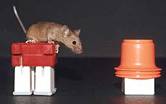
THURSDAY, March 7 (HealthDay News) — Implanting a type of human brain cell into newborn mice makes them “smarter” as adults, scientists have found — an achievement experts say could aid in understanding and treating human brain diseases.
It sounds a bit like science fiction, but many studies have looked at the effects of implanting rodent brains with human cells, said Paul Sanberg, a professor of neuroscience at the University of South Florida, in Tampa.
What’s new here is that researchers were able to implant mice with human brain cells called glial cells, see those cells mature and act like human ones, and see the effects on the mice’s learning, said Sanberg, who was not involved in the research.
“That’s exciting,” he said. “The cells were still functioning like human cells, and they actually enhanced aspects of learning.”
The goal, though, is not to create brainy mice. The hope is to open up new ways to understand human brain diseases and develop therapies for them, said Dr. Steven Goldman, chairman of neurology at the University of Rochester, in New York, and one of the researchers on the study.
Human brains have different types of cells. Neurons are considered the workhorses, sending electrical and chemical signals to each other. Glial cells are seen as “support” cells that help transfer information among neurons.
But the relative size of glial cells in the human brain is bigger compared to non-primate animals. Humans also have more of them, and greater diversity in them, Goldman said. It has been thought that the evolution of glial cells may have been important to allowing humans to become as smart as they are.
The new findings, which appear in the March 7 issue of the journal Cell Stem Cell, support that theory.
Sanberg said there has already been a growing appreciation of the importance of glial cells in degenerative brain diseases. Multiple sclerosis is the “classic example of a glial disease,” he said. But research suggests impaired glial cells are involved in an array of disorders, including Parkinson’s disease and Alzheimer’s.
Being able to study the function — and dysfunction — of human glial cells in rodent brains could give researchers insight into many diseases, Sanberg and Goldman said.
For the study, Goldman’s team implanted human glial stem cells into the brains of newborn mice. Stem cells are primitive cells that give rise to mature, specialized cells.
The researchers found that over time, the human glial stem cells matured and replaced the mouse glial cells — in essence, “taking over their brains,” Goldman said.
His team then used mouse-appropriate learning tests — like the classic escape-from-the-maze challenge — to compare the animals’ functioning with that of mice with no human glial cells.
“We thought these mice should be smarter. They should be able to learn faster,” Goldman said. “And that’s what we found.”
“It’s a remarkable finding,” said James McGaugh, a research professor of neurobiology and behavior at the University of California, Irvine.
The results “elevate the role” of glial cells in human brain functioning, said McGaugh, who was not involved in the research. As for human health and disease, he added, “I don’t see any immediate implications. But clearly these are exciting findings that warrant further investigation.”
Goldman and his colleagues are already using this line of research to study human disease. In a study published last month, they reported that they have been able to take stem cells from the skin of patients with certain brain diseases and use them to generate glial stem cells. The cells can be implanted into mice to gain a better understanding of those disorders, and to test new therapies, Goldman said.
Right now, the researchers are experimenting with cells taken from patients with schizophrenia and Huntington’s disease.
More information
Learn more about degenerative brain diseases from the U.S. National Institute of Neurological Disorders and Stroke.

